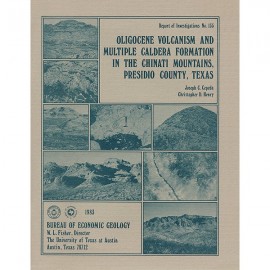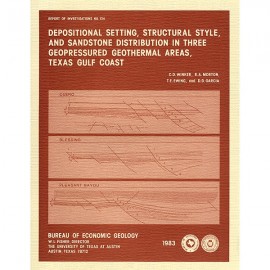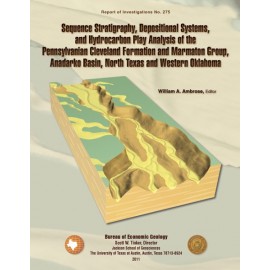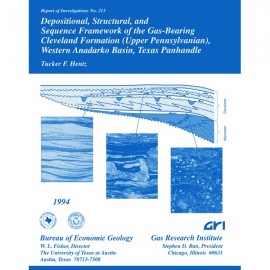Reports of Investigations
-
Books & Reports
- Reports of Investigations
- Guidebooks
- Udden Series
- Geological Circulars
- Down To Earth
- Atlases of Major Oil and Gas Reservoirs
- Texas Memorial Museum Publications
- Environmental Geologic Atlas of the Texas Coastal Zone
- Mineral Resource Circulars
- Other Reports
- Seminars and Workshops
- Handbooks
- Submerged Lands of Texas
- Symposia
- Annual Reports
- Open File Reports
-
Maps & Cross Sections
- Thematic Maps
- Miscellaneous Maps, Charts & Sections
- Geologic Atlas of Texas
- STATEMAP Project Maps
- Geologic Quadrangle Maps
- Cross Sections
- Highway Geology Map
- Energy and Mineral Resource Maps
- Shoreline Change and Other Posters
- Wilcox Group, East Texas, Geological / Hydrological Folios
- Bouguer Gravity Atlas of Texas
- River Basin Regional Studies
- Featured Maps
- Posters
- Teachers & the Public
-
Geological Society Publications
- Gulf Coast Association of Geological Societies
- Alabama Geological Society
- Austin Geological Society
- Corpus Christi Geological Society
- Houston Geological Society
- Lafayette Geological Society
- Mississippi Geological Society
- New Orleans Geological Society
- South Texas Geological Society
- GCS SEPM Publications
- Historic BEG & UT Series
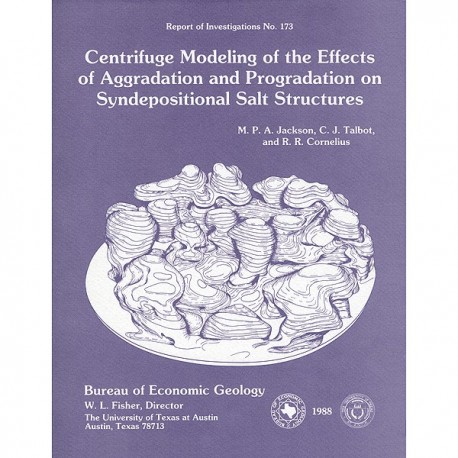
Centrifuge Modeling of the Effects of Aggradation and Progradation on Syndepositional Salt Structures
RI0173
For a downloadable, digital version: RI0173D.
RI0173. Centrifuge Modeling of the Effects of Aggradation and Progradation on Syndepositional Salt Structures, by M.P.A. Jackson, C. J. Talbot, and R. R. Cornelius. 93 p., 67 figs., 9 tables, 7 appendices, 1988. ISSN: 0082335X: Print.
To purchase this publication as a downloadable PDF, please order RI0173D.
EXTENDED ABSTRACT
The manner in which sedimentary overburden accumulates significantly influences the growth of syndepositional salt structures. To determine the general principles of this influence for application to specific instances in nature, we carried out 16 experiments using scaled centrifuged models to simulate the effect of variable sedimentary loading on the geometry, kinematics, and dynamics of syndepositional salt structures. This topic has been almost entirely ignored in both physical and mathematical modeling of salt structures.
The rheology of four modeling materials was determined. The equivalent shear viscosity of terrigenous clastic overburdens in the Mesozoic section of a Gulf Coast interior basin and in the Pleistocene section of the northern Gulf of Mexico was estimated by dynamic scaling to be 5 x 1020 Pa*s and 3 x 1020 Pa*s, respectively; the equivalent viscosity of Mesozoic Gulf Coast carbonates was estimated to be 2 x 1020 Pa*s.
Thirteen models were centrifuged under 1200 g; 14 experiments were dynamically scaled so that the ratios of viscous, pressure, and gravity forces were equivalent to conditions thought to be found in nature. Four types of experiments were carried out: (1) illustration of edge effects; (2) comparison of diapiric growth by upbuilding versus downbuilding; (3) simulation of static differential loading; and (4) simulation of prograding differential loading.
Edge effects represent the influence of the shape of the experimental container on the geometry and growth of source structures one to two diapir spacings inward from the container boundary. The most important edge effect was the rapid growth of a peripheral wall at the model perimeter. This effect was filtered out during model interpretation. Upbuilding occurs during postdepositional or interdepositional diapiric growth; the diapir crest rises while the base remains static. Downbuilding occurs during syndepositional diapiric growth while the overburden aggrades (accumulates vertically); the crest is static while the base sinks along with the basin floor. Both processes are extreme and ideal. R/A growth curves summarize objectively the incremental and finite growth history of natural and model domes. An overall trend of downbuilding growth can be produced by alternating episodes of burial and upbuilding during episodic sedimentation.
The experiments showed that, compared with analogous upbuilding structures, downbuilding domes (1) rose more slowly, (2) formed more closely together, (3) formed double-stalked domes more readily, (4) formed exposed walls more commonly, and (5) developed peripheral hanging lobes more readily. A stiff, dense "carbonate" layer, such as the Upper Jurassic and Cretaceous units in Gulf Coast interior basins, had an important control on the form of domes rising through the layer.
Several features characterized both upbuilding and downbuilding models. Where the uppermost cover was the same density as the source layer, mature domes were surmounted by a bulb. The bulb spread laterally at roughly the same depth as the deepest part of the uppermost cover.
Where the uppermost cover was denser than the source layer, diapirs that pierced it extruded to form mounds surrounded by moats depressed by differential loading. Lateral flow was centrifugal over rising fingers of source and was convergent or parallel in sinking walls of cover. Upbuilding and downbuilding models were characterized by spoke circulation, in which shallow polygonal walls of cover enclosing rising source fingers overlay deep polygonal walls of source enclosing sinking cover fingers.
A model containing a wedge-shaped source layer simulated the zonation of salt structures on the flanks of Gulf Coast interior basins. As proposed in analytical theory, domes grew fastest where the wedge was thickest. During static differential loading by a half-layer over tabular cover and buoyant source layer, a frontal wall was squeezed ahead of and parallel to the edge of the half-layer. Differential loading was equally effective on the source layer and on the overlying tabular cover, causing all diapirs to tilt toward the foundered edge of the half-layer. Diapirs next to the half-layer were more tilted and more asymmetrical than those beneath it. During simulated sedimentary progradation, buoyant source material was initially squeezed ahead of the depocenter, but flow reversed direction as source layers became completely buried. After being overridden by progradation, frontal bulges of source initiated diapiric walls parallel to the advancing linear depocenter. The walls were tilted in a direction opposite that of progradation, analogous to salt walls in the Gulf of Mexico.
Dense cover also prograded across the edge of source layers beyond the confines of the basin. A recumbent, isoclinal wall of source material grew laterally for distances of at least five times the height of mature vertical domes. The recumbent wall, decorated with asymmetrical appendages and overhung by smaller recumbent walls, geometrically resembled the Sigsbee nappe complex on the continental slope of the northern Gulf of Mexico. The recumbent wall acted as a horizontal recycled source layer, allochthonously perched high in the stratigraphic pile, from which a second generation of vertical structures rose.
Several effects, such as those due to source dip, cover wedge, and gravity spreading, favor growth of diapirs that tilt and are asymmetrical toward-basin centers under both static and dynamic loading conditions. First-order circulation of both source and cover in movement cells encompassing several diapirs strongly affects the geometry of second-order movement cells comprising individual diapirs.
Keywords: diapirism, diapirs, flow folds, Gulf of Mexico, nappes, physical models, salt domes, salt tectonics, scale models, structural geology
CONTENTS
Extended Abstract
Introduction
Part I: Experimental Methods
The centrifuge
Scaling
Model materials and their rheology
Modeling technique
General theory and nomenclature
Edge effects (models 840410 and 840411)
Assumptions and limitations
Part II: Aggrading Systems
Downbuilding versus upbuilding
Theory
Movement of crest, midpoint, and base during growth
Incremental growth, finite growth, and R/A growth curves
Initial configuration of models 840312-A,B, 840314-B, and 840319-A,B
Experimental results
Two·dimensional strain: vertical plane
Two·dimensional strain: horizontal plane
Three-dimensional finite strain
Wedge-shaped source layer
Previous experimental modeling and theory
Initial configuration of model 840409
Experimental results
Part Ill: Prograding Systems
Static differential loading of source layer
Previous experiments
Initial configuration of model 840402
Experimental results
Prograding differential load over tabular source layer
Previous experiments
Initial configuration of models
Experimental results
Models 840321-A and 840322
Model 840328
Model 840412
Model 840413
Prograding differential load over boundary of tabular source layer
Initial configuration of models
Experimental results
Model 840403
Model 840423
Discussion
Formation of salt walls in nature
Sigsbee nappe complex
Controls on tilt and asymmetry under static loading
Dipping tabular source/ dipping tabular cover
Dipping tabular source/ horizontal wedgelike cover
Horizontal wedgelike source/horizontal wedgelike cover
Horizontal tabular source/horizontal half-layer cover
Controls on tilt and asymmetry under dynamic loading
Kinematic considerations during progradation
Inherited asymmetry
Distal gravity spreading
Progradation across a basin edge
Thrust-initiated asymmetry and gravity spreading
Summary
Acknowledgments
References
Appendices
1. The centrifuge
2. Model material test methodology and data
3. Spin time, angular velocity, and centrifugal acceleration
4. Edge effects
5. R/A theory
6. Correction of measurements taken from slightly distorted model slices
7. Curve-fitting by quadratic interpolation and by running averages
Figures
1. Rheology of model materials used
2. Edge effects in rectangular container shown by plan views of model 840410 at successive stages
3. Map of model 840410 showing relation between base of RG source upwalls, suture between bulbs, and outline of upwalls above mercury level
4. Edge effects in circular container shown by plan views of model 840411 at successive
5. Schematic vertical sections showing processes of- upbuilding, mixed building, downbuilding, and intermediate types at four sequential time stages
6. Schematic vertical sections showing special cases of halokinesis not included in figure 4 at three sequential time stages
7. Principle of R/A growth curves
8. R/A growth curves for schematic salt domes shown in figures 5 and
9. Dimension of time in R/A graphs
10. Episodic sedimentation shown by Tertiary mean rates of accumulation of terrigenous elastic sediments in two major basin
11. R/A growth curve showing how alternating episodes of pure burial and pure upbuilding, characteristic of episodic sedimentation, can produce overall pure downbuilding
12. Initial configuration of five models in vertical section before acceleration in centrifuge
13. R/A growth curves of downbuilding and upbuilding centrifuged models
14. Step vertical slices of downbuilding model 840312-A
15. Step vertical slices of upbuilding model 840312-B
16. Step vertical slices of downbuilding model 840314-B
17. Step vertical slices of downbuilding model 840319-A
18. Step vertical slices of upbuilding model 840319-B
19. Serial vertical slices of final step of downbuilding model 840319-A
20. Graphs showing relation between wavelength and cover thickness in downbuilding models at different steps
21. Schematic vertical sections showing relation between neutral-density surface and spreading level of diapir bulbs
22. Graphs showing relation between heights of bulb overhangs and neutral-density surface trough points
23. Maps of downbuilding model 840319-A showing surface strains induced during step 3
24. Structure-contour map of upper surface of source layer constructed from data from vertical and horizontal serial slices of final step of downbuilding model 840319-A
25. Structure·contour map of upper surface of source layer constructed from data from vertical and horizontal serial slices of final step of upbuilding model 840319-B
26. Isometric block diagram of upper surface of source layer of downbuilding model 840319-A constructed from figure 24
27. Isometric block diagram of upper surface of source layer of upbuilding model 840319-B constructed from figure 25
28. Serial horizontal slices of final step of downbuilding model 840319·A and upbuilding model 840319-B
29. Serial horizontal slices of .final step of downbuilding model 840314-B
30. Maps of downbuilding model 840319·A and upbuilding model 840319-B comparing distribution of deep ridgelike upwalls of source, shallow fingers of source, troughlike downwalls of cover at surface, and axial tilts of fingers
31. Initial configuration of downbuilding model 840409 and of static differential·loading model 8404-02 in vertical section before acceleration in centrifuge
32. Step vertical slices of downbuilding model 840409
33. Correlation between wavelength of fingers and walls and initial thickness of source wedge in downbuilding model
34. Mass·flow data for static differential-loading model 840402 based on measured areas in serial vertical slices of final step after 52 h
35. Two representative vertical slices of final step of differential·loading model 840402
36. Isometric block diagram of tightly packed serial vertical slices of final step of static differential·loading model 840402 showing three·dimensional configuration of source layer
37. Serial horizontal slices of final step of differential·loading model 840402
38. Tilt data for loaded and unloaded sides of final step of static differential·loading model 840402
39. Initial configuration of prograding models 840321-A and 840322 in vertical section before acceleration in centrifuge
40. Initial configuration of prograding models 840328, 840412, and 840413 in vertical section before acceleration in centrifuge
41. Step vertical slices of prograding model 840321-A
42. Step vertical slices of prograding model 840322
43. Isometric block diagram of part of asymmetrical peripheral wall of prograding model 840322 at final step
44. Step vertical slices of prograding model 840328
45. Isometric block diagram of upper surface of source layer of prograding model 840328 at final step
46. Mass-flow data from step slices of prograding model 840328 plotted against
47. Tilt data for prograding model 840328
48. Surface strains ahead of prograding wedge of cover in model 840412 at two stages
49. Representative vertical slice from final step of prograding model 840412
50. Step vertical slices of prograding model 840413
51. Structure-contour map of upper surface of source layer of prograding model 840413 showing walls formed by progradation from W to E
52. Isometric block diagram of upper surface of source layer of model 840413 at final step showing walls formed by progradation from W to E
53. Mass·flow data from prograding model 840413 plotted against time
54. Tilt data from prograding model 840413
55. Initial configuration of prograding models 840403 and 840423 in vertical section before acceleration in centrifuge
56. Step vertical slices of prograding model 840403
57. Serial vertical slices of final step of prograding model 840403
58. Extreme asymmetry of finger and of distal appendages adjacent to basement step in serial vertical slice of prograding model 840403
59. Second-order structures formed over basement step in serial vertical slices of prograding model 840403
60. Second-order structures formed at leading edge of principal recumbent wall in serial vertical slices of prograding model 840403
61. Serial horizontal slices of prograding model 840403 after final step
62. Step vertical slices of prograding model 840423
63. Serial vertical slices of prograding model 840423
64. Vertical serial slices of prograding model 840423
65. Vertical cross section of crust underlying coastal plain, continental shelf, slope, and abyssal plain in the northwestern Gulf of Mexico
66. Schematic vertical sections showing in right columns effects of various influences on tilt and asymmetry of diapirs formed from configurations shown in left columns
67. Schematic diagram showing relations between cover progradation rate, migration rate of frontal bulge of laterally squeezed source material, diapir rise rate, and width of each increment of prograding cover
Tables
1. Summary of experiments
2. Comparison of rates and ratios of progradation, aggradation, and diapir rise in prototypes and models
3. Dynamic scaling of model 840314-B
4. Dynamic scaling of model 840319-A
5. Dynamic scaling of model 840328
6. Dynamic scaling of model 840413
7. Creep rheology of model materials
Appendix Tables
A2-1. Rheologic test data from four modeling materials
A3-1. Tabulation of spin time, angular velocity, and acceleration of each step in centrifuged models
Citation
Jackson, M. P. A., Talbot, C. J., and Cornelius, R. R., 1988, Centrifuge Modeling of the Effects of Aggradation and Progradation on Syndepositional Salt Structures: The University of Texas at Austin, Bureau of Economic Geology, Report of Investigations No. 173, 93 p.

